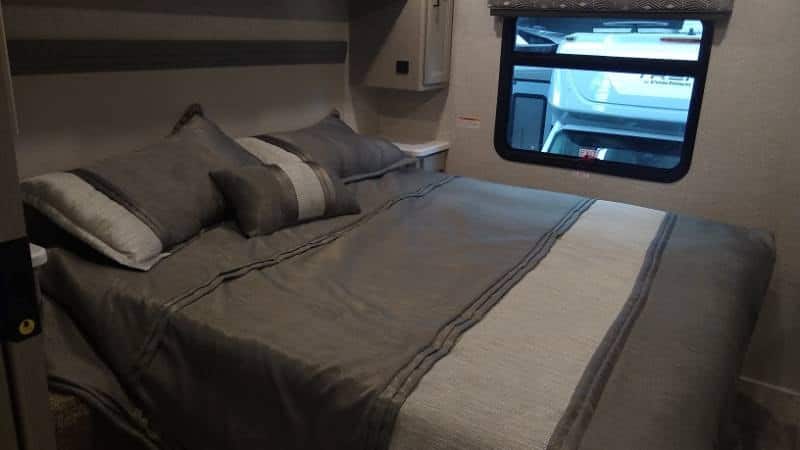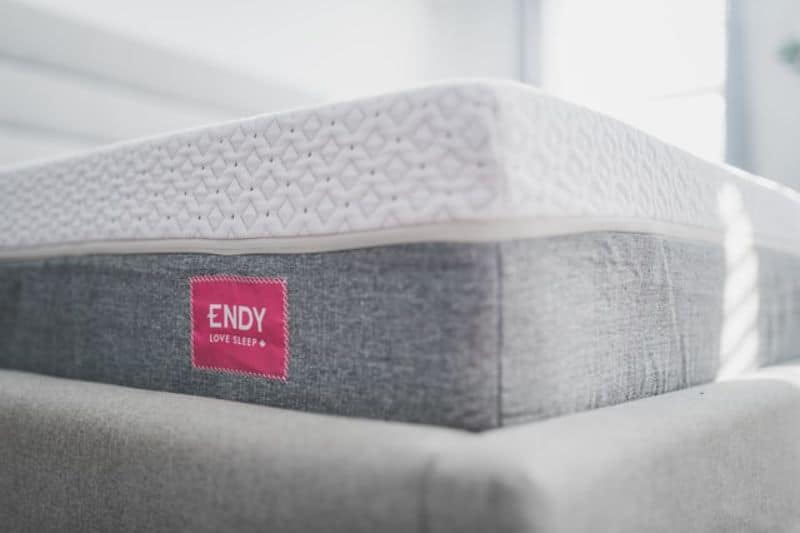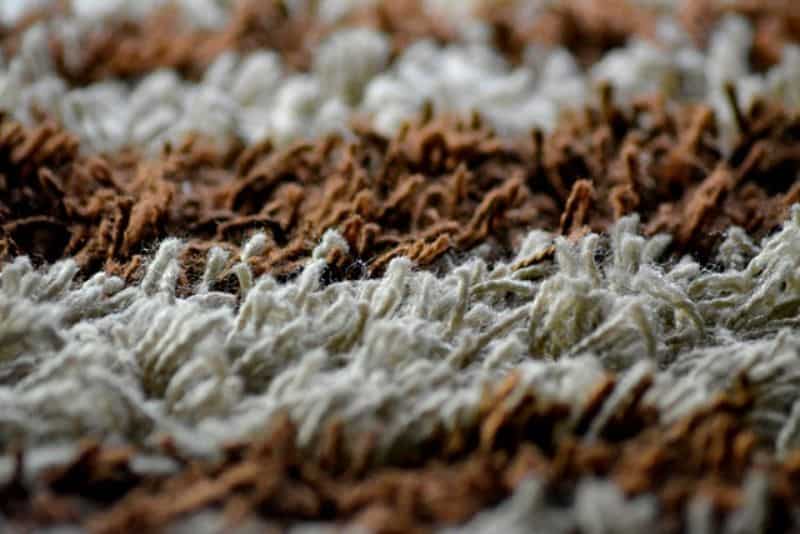Today, I’m taking a furlough from my usual topics of electricity, towing, and poop, and taking a foray into the world of interior design. (Or lack thereof.)
Today’s topic: Your RV mattress. And why your dog has a more comfortable bed than you.
Let’s begin with some brutal honesty: Your RV mattress probably sucks. And the reason why is pretty simple.

Why Are RV Mattresses So Uncomfortable??
The Big Boys of Elkhart, Indiana go fishing for nickel-and-dime savings. There’s a $100 difference (at least) between a good mattress and a bad one. For a manufacturer that celebrates saving $2 a camper, a $100 savings is too juicy to pass up.
Smaller players are forced to play lowball. Since so many customers buy RVs based on first impressions, not many first-time buyers will spend the extra hundred$ to buy an RV just because it has a “nicer mattress.” It’s a forced race to the bottom.
(Plus, as silly as it may sound, a cheap mattress is a lightweight mattress! And RV companies do love lightweight things).
Today, experienced RV buyers know that most RV mattresses stink. They expect to shell out another $100-$1,000 to buy a replacement mattress. A crummy mattress doesn’t deter the sale.
Plus, as I wrote in my open letter about the RV black tank, much of the RV industry lets the aftermarket do its dirty work.
So, that’s why your RV mattress isn’t much good. The manufacturer knows you’ll still accept the sale.
(Honestly, I suspect the only reason RV manufacturers include a mattress is for show staging. Seems like everyone would save money if we just shipped RVs empty and let the customer choose their own mattress! But I digress.)
What Makes the Mattress So Awful?
Most uncomfortable RV mattresses are just rectangular slabs of foam on a plywood base. (And last I checked, plywood stinks to sleep on).
There’s nothing inherently wrong with a foam mattress – but the details matter! Foams have many mechanical properties:
- Thickness
- Density
- Firmness [usually measured by the Impression Load
- Deflection (ILD)]
- Support factor (or compression modulus)
- Air flow (breathability)
- Resiliency (springback)
- And more!
So as you can see, a slab of foam is actually a pretty complex thing! (I’ll talk more about mattress specifications in a later section.)
For now, just understand that RV mattresses typically rank towards the bottom. They are generally made with low-density recycled foam or fiberfill that breaks down quickly with use and exposure to moisture.

Most RV mattresses are too soft. They provide very little compression support and pressure point relief. They feel comfortable to sit on, but they don’t maintain proper posture and spinal alignment. They lack firmness deep down in the foam, where it counts the most.
- Common side effects of a soft mattress: Many RV users complain of lower back aches and pains from sleeping on an RV mattress. This is because your spine is out of whack.
A few RV mattresses have the opposite effect. They are too stiff. But excessive firmness can exert major stress on the pressure points on your hips, shoulders, and head.
Firm mattresses support your spine but can cause localized pain and soreness. This can be especially problematic for side-sleepers, who have to twist their spine to accommodate a firm surface.
- Common side effects of a firm mattress: soreness, aches, hip and shoulder pain.
How to Make an RV Mattress More Comfortable?
If you’re not able to pony up the cash for a new custom RV mattress, you’re stuck with MacGyvering a solution with your current mattress.
You have two basic options: Put something over the mattress, or under it!
Mattress Topper

Eh … mattress toppers often don’t work. By design, toppers are soft and plush, which won’t help if your RV mattress is also already too soft.
However, mattress toppers can help if your RV mattress is too firm – or even too thin! If you’re sleeping on a 3” or 4” mattress, your bones might be almost compressing the foam to the plywood! By adding a mattress topper, you help redistribute your weight over a large area.
RV mattress topper types include:
- Eggshell foam toppers
- Memory foam toppers
- Featherbed toppers
One kind of topper isn’t necessarily better than the other. Toppers are really about comfort and plushness more than support. So pick whatever you like best!
If you don’t want to purchase an RV mattress topper, just throw on whatever blankets, comforters and sleeping bags you have laying around the house. They work well in a pinch!
Pad the Base

Sometimes, you can bolster a bad mattress by putting something underneath it, rather than over it. You can use carpet, a thick mattress pad, inflatable camping pad – even another mattress!
Unfortunately, padding the base can be a complicated project.
Many RV beds have cabinetry close above them. You might not have any vertical room to increase the height of your mattress. And anything that goes below your mattress needs to be mold-resistant, or you need to add a ventilation system like the Froli system or the Hypervent Aire-Flow.
I recommend loose-laying some surplus carpet under the mattress and seeing if that helps. If possible, flip your mattress every few months to air out the underside. You can also leave your naked mattress in the sun for a few hours to dry it out and kill bacteria.
What Are Standard RV Mattress Sizes?
Ha ha ha, good one.
… Oh, you were serious?
Well, I’ll keep this short. There’s no such thing as a “standard RV mattress.” One time, I crawled into a camper that advertised a “Queen-size bed” – which was only 5’ 9” long!
However … RV designers do typically try to hang around certain sizes, give or take an inch (or two).
| Twin | 39×75 |
| Twin XL | 39×80 |
| RV Three-Quarter | 48×75 |
| Full | 54×75 |
| RV Full | 53×75 |
| Olympic Queen | 66×80 |
| Queen | 60×80 |
| RV Short Queen | 60×75 |
| King | 76×80 |
| Short King | 76×75 |
| RV Short King | 70/72×74 |
| RV King | 70/72×80 |
| California King | 72×84 |
| RV Bunk (Small) | 30×72 |
| RV Bunk (Medium) | 36×75 |
| RV Bunk (Large) | 42×80 |
The bunk bed sizes are a guess, at best. Bunk beds can be as narrow as 24 inches and as short as 60 inches.
Convertible dinettes: All bets are off. Could literally be anything.
To be safe, measure your mattress with a tape measure!
How to Choose a Comfortable RV Replacement Mattress
I’m no mattress engineer, but I have custom-designed a handful of mattresses. Here are some of my takeaways.
When you layer foams in different thicknesses (as premium mattresses often do), you can get all sorts of unique feels and functions.
Different sleepers need different mattresses. Side sleepers, for instance, need a mattress with a soft top layer that relieves pressure points on the shoulders and hips, but a firm bottom layer that can support and distribute full body weight at these points.
Your weight, shape and BMI also have a huge impact on your mattress preference. People with a higher BMI, for instance, need a mattress with a strong core layer for deep support. Meanwhile, people with extremely wide hips and shoulders need a thicker mattress that can cradle their full shape.
Basically, you’re Goldilocks, and you’re looking for just the right mattress for you.
Let’s take a closer look at some of the mattress specifications I mentioned earlier.
1. Minimum Thickness
6” is a minimum! 8” or 10” is better! A thick mattress can better distribute your weight and relieve pressure points.
(You might see 3” or 4” thicknesses for kids’ bunk beds. I would never go thinner for 4” for any bedding application.)

Personally, for a foam mattress (not talking about inner-spring mattresses), I don’t think there’s a huge difference in comfort after 10” in height. However, your results may vary. I don’t have 70-year-old joints, either.
2. More Layers!
While there’s nothing inherently wrong with a single-layer foam mattress, it’s hard to find a foam that excels across the board.
So premium foam mattress manufacturers will layer two, three, even four layers of foam!
- Foundation layer (bottom): Responsible for mattress longevity
- Support layer (middle): Responsible for optimum pressure
- Comfort layer (top): Responsible for feel, skin comfort, pressure point relief. This is what makes a mattress feel “plush.”
You generally won’t find multi-layer mattresses less than 6-8” thick.
3. More Density
Don’t confuse density with firmness. Density is more an indication of the construction quality. As a rule, the more dense the foam, the longer the mattress will last.
You want a foam mattress with a density of at least 1.8-2.2 lbs. Anything rated 1.5-lb density or below is a very poor choice for a mattress.
4. Balanced Firmness
Firmness is usually measured by the Impression Load Deflection (ILD). That refers to the pounds of pressure needed to indent a 4” thick piece of the foam to by 25 percent. In other words, how much force is required to indent the foam by 1 inch. That’s considered the 25% ILD rating.
(There’s a whole formal test for this procedure. It’s called the ASTM D3574, if you’re interested.)
Anyway, here’s how to interpret the numbers:
- 14: Super Plush
- 19: Plush
- 24: Soft
- 28: Medium
- 32: Firm
- 36: Extra Firm
- 40+: Base Core
This test tells you the “feel” of the mattress.

5. Support Factor
The support factor is also known as the compression modulus. It’s measured as a ratio of 65% ILD to 25% ILD.
Alright, alright, no more math! What the support factor tells you is how much “deep support” a mattress has. How well does it support your pressure points and maintain proper posture?
Most manufacturers don’t publish support factor numbers, sadly. You’re looking for something around 2.0 or higher.
6. Good Breathability
Have you ever heard the complaint that memory foam “sleeps hot”? That’s a classic complaint against typical memory foam.
Hot mattresses can cause significant discomfort and sweating. Some types of mattresses absorb and retain heat. In an RV mattress, that is usually undesirable.
The classic coil spring mattress dissipates heat very well, thanks to the breathability of air moving easily through the coils.
Meanwhile, a closed-cell foam mattress has very poor heat-wicking properties. That’s great in the winter, but torture in the summer!
Mattresses that sleep cool include:
- Memory foam with gel infusion
- Natural latex mattresses
- Coil spring mattresses
All-foam mattresses typically “sleep hot.” Premium foam mattresses, like Purple, tend to get around this fact with grid patterns and other designs that allow air to escape through air channels and open pockets.
7. Motion Isolation
This isn’t a specification, per se, but it’s a helpful concept.
One of the reasons a lot of people like memory foam is because it isolates movement. So when your partner is kicking or rolling, you’re sleeping quietly away.
If you sleep with a mobile partner, you might like memory foam better than, say, latex, which is naturally more rubbery and springy.
(Unfortunately, your partner will hate memory foam, because it fights against you as you move, and it takes a while to adapt to a new position. Hey, no one said marriage was easy!)

There’s a balance in between a responsive mattress, which responds quickly to changes in position, and a conforming mattress, which cradles the curves of your shape. Different sleepers prefer different characteristics.
8. Low Emissions
As I wrote in my treatise on RV indoor air quality, you don’t want to mess around with VOCs and other nasty emissions inside your RV.
Unfortunately, most foam mattresses off-gas some sort of product that can cause respiratory illness or sensitivity.
- At a minimum, make sure any foam mattress you purchase has a CertiPur-US certification!
- Another good certification is GreenGuard Gold for low VOCs.
- If it’s a latex product, look for the GOLS and/or Oeko-Tex certifications.
Most mattresses and pillows should be allowed to thoroughly off-gas before being used.
What’s the Best Type of RV Replacement Mattress?
Ooh boy … this is a hot topic! And, to be honest, I’m not going to tackle it.
There are a lot of companies that pay big bucks in marketing to convince you that their mattress is the best.
I used to sleep just fine on an innerspring mattress questionably sourced from a thrift store, so I’m not the right guy to answer that question. (Now I’ve upgraded to a Zinus medium-firm 10″ foam mattress. Love that thing!)
So if you’re looking to spend $1,000 or more on a custom RV mattress, then I’m not sure whether a Dunlop latex or a gel-infused memory foam triple-layer mattress is the one for you. With that said, here are the most common types of RV replacement mattresses:
- Polyurethane foam
- Latex: Natural (Talalay or Dunlop), or synthetic (SBR).
- Air mattress
- Inflatable RV Mattress
- Memory foam
- Coil spring
For various practical reasons, most replacement RV mattresses are foam. Foam can be easily cut-to-shape.
As far as how much a replacement RV mattress costs … that’s entirely up to you. You can source a basic 6” single-layer, high(ish) quality memory foam or poly foam mattress for $200 or less (depending on size).
On the other hand, a premium 12” custom-made RV mattress with coil spring edge support, triple foam layers, gel cooling technology and quilted pillow top … well, you can either have a mattress, or a used car.
Here are some companies that specialize in premium RV replacement mattresses:
If you’re comfortable selecting your own foam core and upholstering your own mattress, you can buy foam online at sites like The Foam Factory.

One last piece of advice.
All too often, new RV owners discover how much they hate their mattress after a weekend of restless sleep and sore joints.
Do yourself a favor and go mattress shopping before you buy your RV. Then install your new mattress (properly aired out, I hope) before beginning, and enjoy that maiden voyage!
Leave a Reply